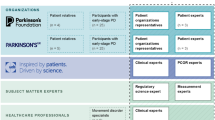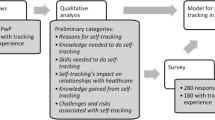Abstract
Background and objectives
The 26-item Parkinson disease dyskinesia scale (PDYS-26) was developed to assess the impact of Parkinson’s disease levodopa-induced dyskinesias (PD-LID). The purpose of this qualitative research study was to assess the content validity of the PDYS-26 in an independent sample and to use the findings to suggest a conceptual framework around the impact of PD-LID.
Methods
PD patients experiencing LID and their caregivers were recruited from four US clinical sites. Stage I involved 22 qualitative concept elicitation interviews with patients and caregivers, and 11 qualitative cognitive interviews (CI) with patients about the PDYS-26. The PDYS-26 was modified based on Stage I findings. Stage II consisted of 13 CI on the Modified PDYS.
Results
Forty-six participants were interviewed across both stages of the study. Patient mean age was 67.3 (SD ± 9.55) years; 19 (54.3 %) female; 34 (97.1 %) white. The content validity of the PDYS-26 was generally supported. A revised conceptual framework with three hypothesized domains (body control, activities of daily living, social consequences) was developed. Modifications were made to the PDYS-26 (i.e., emphasizing LID in the instructions; response scale modification; deleting or modifying items), which resulted in the 22-item Modified PDYS.
Conclusions
Stage I and II findings suggested a number of modifications to the scale in order to improve the content validity. Psychometric testing of the revised scale with a larger patient sample is suggested to evaluate item performance, establish scoring, and provide quantitative support for the conceptual framework.

Similar content being viewed by others
References
Encarnacion, E. V., & Hauser, R. A. (2008). Levodopa-induced dyskinesias in Parkinson’s disease: Etiology, impact on quality of life, and treatments. European Neurology, 60(2), 57–66. doi:10.1159/000131893.
Thanvi, B., Lo, N., & Robinson, T. (2007). Levodopa-induced dyskinesia in Parkinson’s disease: Clinical features, pathogenesis, prevention and treatment. Postgraduate Medical Journal, 83(980), 384–388. doi:10.1136/pgmj.2006.054759.
Jankovic, J. (2008). Parkinson’s disease and movement disorders: Moving forward. The Lancet Neurology, 7(1), 9–11. doi:10.1016/S1474-4422(07)70302-2.
Brotchie, J. M., Lee, J., & Venderova, K. (2005). Levodopa-induced dyskinesia in Parkinson’s disease. [Research Support, Non-U.S. Gov’t Review]. Journal of Neural Transmission, 112(3), 359–391. doi:10.1007/s00702-004-0251-7.
Verhagen Metman, L. (2002). Recognition and treatment of response fluctuations in Parkinson’s disease: Review article. Amino Acids, 23(1–3), 141–145. doi:10.1007/s00726-001-0119-1.
Bargiotas, P., & Konitsiotis, S. (2013). Levodopa-induced dyskinesias in Parkinson’s disease: Emerging treatments. Neuropsychiatr Dis Treat, 9, 1605–1617. doi:10.2147/NDT.S36693.
Iravani, M. M., & Jenner, P. (2011). Mechanisms underlying the onset and expression of levodopa-induced dyskinesia and their pharmacological manipulation. Journal of Neural Transmission, 118(12), 1661–1690. doi:10.1007/s00702-011-0698-2.
Ostergaard, K., Sunde, N., & Dupont, E. (2002). Effects of bilateral stimulation of the subthalamic nucleus in patients with severe Parkinson’s disease and motor fluctuations. [Clinical Trial Research Support, Non-U.S. Gov’t]. Movement Disorders, 17(4), 693–700. doi:10.1002/mds.10188.
Schrag, A., & Quinn, N. (2000). Dyskinesias and motor fluctuations in Parkinson’s disease. A community-based study. [Research Support, Non-U.S. Gov’t]. Brain, 123(Pt 11), 2297–2305.
Nutt, J. G., Chung, K. A., & Holford, N. H. (2010). Dyskinesia and the antiparkinsonian response always temporally coincide: A retrospective study. [Research Support, N.I.H., Extramural Research Support, Non-U.S. Gov’t Research Support, U.S. Gov’t, Non-P.H.S.]. Neurology, 74(15), 1191–1197. doi:10.1212/WNL.0b013e3181d90050.
Obeso, J. A., Olanow, C. W., & Nutt, J. G. (2000). Levodopa motor complications in Parkinson’s disease. [Case Reports Review]. Trends in Neurosciences, 23(10 Suppl), S2–S7.
Colosimo, C., Martinez-Martin, P., Fabbrini, G., Hauser, R. A., Merello, M., Miyasaki, J., et al. (2010). Task force report on scales to assess dyskinesia in Parkinson’s disease: Critique and recommendations. Movement Disorders, 25(9), 1131–1142. doi:10.1002/mds.23072.
Goetz, C. G., Nutt, J. G., & Stebbins, G. T. (2008). The unified dyskinesia rating scale: Presentation and clinimetric profile. [Research Support, N.I.H., Extramural Research Support, Non-U.S. Gov’t]. Movement Disorders, 23(16), 2398–2403. doi:10.1002/mds.22341.
Goetz, C. G., Stebbins, G. T., Shale, H. M., Lang, A. E., Chernik, D. A., Chmura, T. A., et al. (1994). Utility of an objective dyskinesia rating scale for Parkinson’s disease: Inter- and intra-rater reliability assessment. [Clinical Trial Research Support, Non-U.S. Gov’t]. Movement Disorders, 9(4), 390–394. doi:10.1002/mds.870090403.
Guy, W. (1976). ECDEU assessment manual for psychopharmacology (revised ed.). Washington, DC: US Department of Health, Education, and Welfare.
Jenkinson, C., Fitzpatrick, R., Peto, V., Greenhall, R., & Hyman, N. (1997). The PDQ-39: Development and validation of a parkinson’s disease summary index score. Age and Ageing, 26, 353–357.
Katzenschlager, R., Schrag, A., Evans, A., Manson, A., Carroll, C. B., Ottaviani, D., et al. (2007). Quantifying the impact of dyskinesias in PD: The PDYS-26: A patient-based outcome measure. [Research Support, Non-U.S. Gov’t Validation Studies]. Neurology, 69(6), 555–563. doi:10.1212/01.wnl.0000266669.18308.af.
Martinez-Martin, P., Gil-Nagel, A., Gracia, L. M., Gomez, J. B., Martinez-Sarries, J., & Bermejo, F. (1994). Unified Parkinson’s disease rating scale characteristics and structure. The cooperative multicentric group. [Multicenter Study]. Movement Disorders, 9(1), 76–83. doi:10.1002/mds.870090112.
Parkinson’s Study Group (2001). Evidence of dykinesias in pilot, randomized, placebo-controlled trial of remacemide in advanced parkinsons disease. Archives of Neurology, 58, 1660–1668.
Peto, V., Jenkinson, C., & Fitzpatrick, R. (1998). PDQ-39: A review of the development, validation and application of a Parkinson’s disease quality of life questionnaire and its associated measures. Journal of Neurology, 245(Suppl 1), S10–S14.
Goetz, C. G., Stebbins, G. T., Chung, K. A., Hauser, R. A., Miyasaki, J. M., Nicholas, A. P., et al. (2013). Which dyskinesia scale best detects treatment response? [Randomized Controlled Trial Research Support, Non-U.S. Gov’t]. Movement Disorders, 28(3), 341–346. doi:10.1002/mds.25321.
Patrick, D. L., Burke, L. B., Gwaltney, C. J., Leidy, N. K., Martin, M. L., Molsen, E., et al. (2011). Content validity—Establishing and reporting the evidence in newly developed patient-reported outcomes (PRO) instruments for medical product evaluation: ISPOR PRO good research practices task force report: Part 2—Assessing respondent understanding. Value in Health, 14(8), 978–988. doi:10.1016/j.jval.2011.06.013.
Patrick, D. L., Burke, L. B., Gwaltney, C. J., Leidy, N. K., Martin, M. L., Molsen, E., et al. (2011). Content validity—Establishing and reporting the evidence in newly developed patient-reported outcomes (PRO) instruments for medical product evaluation: ISPOR PRO good research practices task force report: part 1–Eliciting concepts for a new PRO instrument. Value in Health, 14(8), 967–977. doi:10.1016/j.jval.2011.06.014.
Willis, G. B. (2005). Cognitive interviewing: A tool for improving questionnaire design. Thousand Oaks, CA: Sage Publications Inc.
Conflict of interest
This study was sponsored by Novartis AG. J.P. is an employee of Novartis. C.K. was an employee of Novartis at the time of the study. A.E.S. is employed by the University College of London, in London, UK. W.R.L., S.M. and A.L. are employees of Evidera which received funding from Novartis for services performed in connection with the development of this qualitative research study and manuscript.
Author information
Authors and Affiliations
Corresponding author
Rights and permissions
About this article
Cite this article
Lenderking, W.R., Mannix, S., Petrillo, J. et al. Assessment of Parkinson’s disease levodopa-induced dyskinesia: a qualitative research study. Qual Life Res 24, 1899–1910 (2015). https://doi.org/10.1007/s11136-015-0925-7
Accepted:
Published:
Issue Date:
DOI: https://doi.org/10.1007/s11136-015-0925-7




